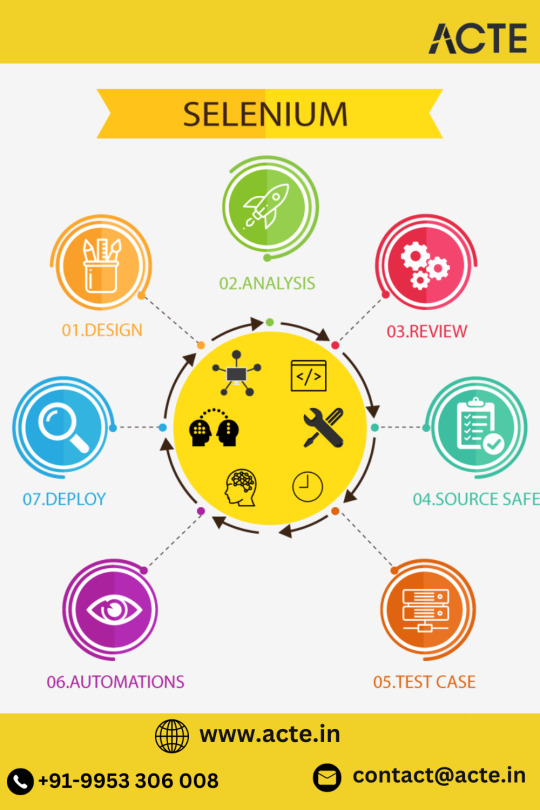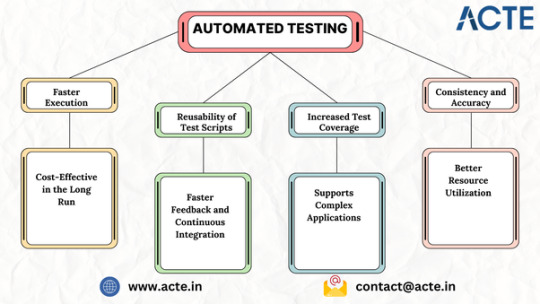#selenium training in chennai
Explore tagged Tumblr posts
Text
#automation testing#testleaf#software testing#quality control#quality assurance#qc#manual testing#selenium training in chennai
0 notes
Text
Selenium Unleashed: Navigating the Dynamics of Web Application Automation
In the fast-paced world of software development, the need for efficient and reliable testing processes has led to the widespread adoption of Selenium—an open-source framework renowned for its prowess in automating web applications.
This versatility makes it the framework of choice for a diverse array of development environments, further emphasizing its significance in the realm of automated testing and underlining its importance in Selenium training in Chennai. This blog aims to unravel the intricacies of Selenium, exploring its key components, and delving into why it stands as the go-to choice for automated web testing.

Understanding Selenium's Toolbox: Key Components
1. Selenium WebDriver: Navigating the Web Programmatically
At the heart of Selenium lies WebDriver, a robust component that allows developers and testers to programmatically interact with web browsers. It furnishes a powerful programming interface for controlling browser behavior, navigating web pages, and interacting with various web elements. WebDriver serves as the backbone for creating dynamic and sophisticated automation scripts.
2. Selenium IDE: Record-and-Play Automation Simplified
Selenium IDE offers a user-friendly approach to automation through its record-and-playback functionality. This browser extension is especially beneficial for beginners, providing an intuitive way to create automation scripts without delving into intricate code. However, while Selenium IDE serves as an excellent starting point, Selenium WebDriver offers advanced users more control and flexibility.
3. Selenium Grid: The Power of Parallel Execution
Selenium Grid is a game-changer for test automation scalability. Its primary function is to facilitate the parallel execution of tests across multiple machines and browsers. By distributing test scripts across different environments simultaneously, Selenium Grid significantly reduces overall test execution time. This efficiency is particularly crucial in today's fast-paced development cycles.
Why Selenium is the Cornerstone of Automated Web Testing:
1. Cross-Browser Compatibility Testing: Ensuring a Seamless User Experience
One of Selenium's standout features is its ability to conduct cross-browser compatibility testing. Web applications must function seamlessly across various browsers, including Chrome, Firefox, Safari, and Internet Explorer. Selenium's prowess in this area ensures a consistent user experience, regardless of the browser a visitor chooses. Elevating its significance, Selenium serves as the linchpin in web application automation, making it an integral part of comprehensive training programs. For aspiring professionals in Chennai, harnessing Selenium's potential is made even more accessible through enrollment in the Best Selenium Training Institute.
2. Automation of Repetitive Tasks: Enhancing Efficiency
Selenium shines in automating repetitive and time-consuming tasks that are inherent in manual testing processes. Whether it's data entry, form submissions, or complex navigation scenarios, Selenium accelerates the testing process, reduces human error, and enhances overall efficiency.
3. Regression Testing: Safeguarding Code Integrity
As applications evolve, it's crucial to ensure that new changes don't compromise existing functionalities. Selenium's automation capabilities make it an ideal choice for regression testing—quickly validating that alterations to the codebase do not introduce unintended consequences to the application's core features.
4. Faster Feedback in Development Lifecycle: Accelerating Releases
Integrating Selenium tests into the development pipeline provides rapid feedback on code changes. This early detection of issues contributes to a faster and more reliable development lifecycle. Developers can address potential problems swiftly, minimizing the chances of bugs persisting into later stages of development.
5. Support for Multiple Programming Languages: Flexibility in Development
Selenium's support for multiple programming languages, including Java, Python, C#, Ruby, and JavaScript, grants developers the flexibility to choose the language that aligns with their preferences or project requirements. This adaptability has contributed significantly to Selenium's widespread adoption across diverse development environments.
6. Flexibility and Extensibility: Tailoring Testing Environments
Selenium's modular architecture and expansive ecosystem of third-party tools enhance its flexibility and extensibility. Teams can integrate Selenium with various testing frameworks, build tools, and reporting tools, tailoring their testing environment to suit specific project needs.
7. Cost-Efficient Testing: Open Source Accessibility
Being an open-source framework, Selenium offers a cost-effective solution for test automation. Organizations can leverage Selenium without incurring licensing fees, making it accessible to businesses of all sizes. The community-driven development ensures regular updates and improvements to keep pace with industry demands.
8. Compatibility with Continuous Integration: Seamless Development Workflow
Selenium seamlessly integrates with popular Continuous Integration (CI) tools like Jenkins. This integration allows automated tests to be triggered automatically with each code commit, ensuring the application's integrity is maintained throughout the development process. The collaboration between Selenium and CI tools streamlines the development workflow.
9. Support for Complex Test Scenarios: Tackling Modern Web Challenges
In the era of modern web applications with intricate user interfaces, Selenium proves its mettle by supporting complex test scenarios. It excels in handling dynamic web elements, pop-ups, and frames—features that are integral to the functionality of today's sophisticated web applications.

In conclusion, Selenium stands as an indispensable tool in the landscape of automated web testing. Whether it's ensuring cross-browser compatibility, accelerating testing processes, or supporting complex test scenarios, Selenium empowers development teams to deliver high-quality web applications. As the software industry continues to evolve, Selenium remains at the forefront, adapting to new challenges and contributing to the creation of robust and reliable web experiences. As a cornerstone of automated web testing, Selenium continues to shape the way software is developed, tested, and delivered to end-users.
2 notes
·
View notes
Text
The Advantages of Python: A Comprehensive Overview
Python has gained immense popularity in the programming world due to its simplicity, flexibility, and powerful capabilities. Considering the kind support of Python Course in Chennai Whatever your level of experience or reason for switching from another programming language, learning Python gets much more fun.

Whether you are a beginner stepping into coding or an experienced developer working on complex projects, Python offers numerous advantages that make it a preferred choice across various industries.
Easy to Learn and Use
Python is known for its clean and readable syntax, making it an excellent choice for beginners. Unlike other programming languages that require complex syntax, Python allows developers to write fewer lines of code while maintaining efficiency. Its simplicity ensures that even those without prior programming experience can quickly grasp the fundamentals and start coding.
Versatile Across Multiple Fields
One of Python’s biggest strengths is its versatility. It is used in web development, data science, artificial intelligence, machine learning, automation, game development, and even cybersecurity. This flexibility allows developers to transition between different domains without having to learn a new language.
Extensive Library and Framework Support
Python offers a vast collection of libraries and frameworks that simplify development tasks. Libraries like NumPy and Pandas are used for data analysis, TensorFlow and PyTorch for machine learning, Flask and Django for web development, and Selenium for automation. These libraries reduce the time and effort needed to build applications, allowing developers to focus on problem-solving.
Strong Community and Learning Resources
Python has a large and active global community that continuously contributes to its growth. Whether you need help debugging code, finding tutorials, or exploring best practices, numerous forums, documentation, and free learning platforms provide valuable support. This makes Python an ideal language for both self-learners and professionals. With the aid of Best Online Training & Placement Programs, which offer comprehensive training and job placement support to anyone looking to develop their talents, it’s easier to learn this tool and advance your career.

Cross-Platform Compatibility
Python is a cross-platform language, meaning it runs smoothly on Windows, macOS, and Linux without requiring major modifications. This feature enables developers to write code once and deploy it across different operating systems, saving time and effort.
Ideal for Automation and Scripting
Python is widely used for automating repetitive tasks, such as web scraping, file management, and system administration. Businesses leverage Python’s scripting capabilities to improve efficiency and reduce manual workloads. Many developers also use it to automate testing processes, making software development more streamlined.
High Demand in the Job Market
Python is one of the most sought-after programming languages in the job market. Companies across industries, including tech giants like Google, Amazon, and Microsoft, rely on Python for various applications. The demand for Python developers continues to grow, making it a valuable skill for those seeking career advancement.
Integration with Other Technologies
Python seamlessly integrates with other programming languages like C, C++, and Java, making it highly adaptable for different projects. This allows developers to enhance existing applications, optimize performance, and work efficiently with multiple technologies.
Conclusion
Python’s ease of use, versatility, and strong community support make it one of the best programming languages for both beginners and experienced developers. Whether you are interested in software development, data science, artificial intelligence, or automation, Python provides the tools and resources needed to succeed. With its continuous evolution and growing adoption, Python remains a powerful choice for modern programming needs.
#python course#python training#python#technology#tech#python online training#python programming#python online course#python online classes#python certification
0 notes
Text
Mastering Selenium WebDriver: Automating Web Testing with Ease
In today’s fast-paced software development world, efficient and reliable testing is essential. Selenium WebDriver is a leading tool for automating web application testing, enabling developers and testers to interact with web browsers programmatically. By replicating real user actions—such as clicking buttons, filling out forms, and navigating between pages—Selenium WebDriver ensures that web applications function as expected across different browsers and platforms.
Manual testing can be time-consuming and prone to human errors. Selenium WebDriver helps overcome these challenges by executing automated scripts that run faster, reduce repetitive workload, and enhance accuracy. Supporting multiple programming languages like Java, Python, and C#, Selenium WebDriver is compatible with popular browsers such as Chrome, Firefox, and Edge. Additionally, it seamlessly integrates with testing frameworks and CI/CD pipelines, enabling continuous testing and early bug detection. If you want to advance your career at the Selenium Training in chennai, you need to take a systematic approach and join up for a course that best suits your interests and will greatly expand your learning path.

Think of Selenium WebDriver as an intelligent virtual tester that interacts with websites just as a human would, but with greater speed and precision. Whether you’re validating a simple website or conducting end-to-end testing for a complex application, Selenium WebDriver provides a robust and scalable solution for web automation.
How Selenium WebDriver Works
Selenium WebDriver automates browser interactions through a series of well-defined steps:
1. Browser Interaction
Sends commands to the browser using a dedicated driver.
Supports various browsers, including Chrome, Firefox, Edge, and Safari.
Can open, navigate, and close web pages automatically.
Allows headless execution for faster, resource-efficient testing without opening a visual browser window.
2. Locating and Interacting with Web Elements
Selenium WebDriver enables automated scripts to interact with elements on a web page:
Identifies elements using locators like ID, Name, Class, XPath, and CSS Selectors.
Performs user actions such as typing input, clicking buttons, and selecting dropdown values.
Handles pop-ups, alerts, and modals to ensure smooth test execution.
Interacts with complex UI components like hover menus, drag-and-drop features, and embedded frames. Professionals in Selenium are in greater demand, and numerous organizations are now providing the Best Online Training & Placement Programs.

3. Automating Test Execution
Executes test scripts automatically, reducing manual effort.
Works with testing frameworks such as TestNG, JUnit, and PyTest for structured testing.
Generates logs and captures screenshots to help debug test failures.
Supports parallel execution to improve efficiency and reduce testing time.
Enables data-driven testing using external files such as CSV, Excel, or databases.
4. Managing Dynamic Elements and Synchronization
Implements implicit and explicit waits to handle dynamic, slow-loading elements.
Manages AJAX-based elements that change without reloading the page.
Ensures elements are visible and clickable before performing interactions.
Helps prevent timing-related issues by synchronizing browser actions with script execution.
Key Benefits of Selenium WebDriver
Increases Efficiency – Reduces manual testing efforts by automating repetitive tasks.
Improves Accuracy – Eliminates human errors and ensures consistent test execution.
Supports Cross-Browser Testing – Verifies application compatibility across different browsers.
Works with Multiple Languages – Supports Java, Python, C#, and other popular programming languages.
Open Source and Community-Driven – Free to use, with continuous updates from a vast developer community.
Final Thoughts
Selenium WebDriver is a game-changer in web testing, making automation accessible and effective for developers and testers alike. Whether you’re a beginner or an experienced tester, mastering Selenium WebDriver will help you streamline testing processes and improve software quality.
0 notes
Text
How to Learn Python as a Beginner: A Practical Approach
Python is one of the most widely used programming languages, known for its simplicity, readability, and versatility. Whether you are new to coding or transitioning from another language, Python is an excellent choice to start with. Considering the kind support of Python Course in Chennai Whatever your level of experience or reason for switching from another programming language, learning Python gets much more fun.

It is used in web development, data science, artificial intelligence, automation, and more. This guide will walk you through a practical approach to learning Python effectively.
Why Learn Python?
Python is popular among beginners because of its clean syntax and easy-to-understand structure. Unlike other programming languages, Python requires fewer lines of code to accomplish tasks, making it beginner-friendly. Additionally, it has a vast ecosystem of libraries and frameworks that simplify development across various domains.
Step 1: Learn the Fundamentals
Before diving into complex applications, it's crucial to understand Python’s basics. Focus on:
Syntax and Variables – Learn how Python handles different data types, including integers, floats, strings, and lists.
Control Structures – Master conditional statements (if-else) and loops (for, while) to control program flow.
Functions – Learn to write reusable code blocks to make your programs efficient and modular.
Data Structures – Get familiar with lists, tuples, dictionaries, and sets for managing data.
Online platforms like W3Schools, Real Python, and official Python documentation are great places to start learning these concepts.
Step 2: Practice with Small Projects
Once you grasp the basics, start working on small projects to reinforce your learning. Some beginner-friendly project ideas include:
A simple calculator
A to-do list application
A guessing game
A password generator
Building real-world projects helps you understand how Python is applied practically.
Step 3: Explore Python Libraries
Python's power lies in its extensive collection of libraries. As you advance, explore the following:
NumPy and Pandas – For data analysis and manipulation
Matplotlib and Seaborn – For data visualization
Flask and Django – For web development
Selenium – For web automation
TensorFlow and Scikit-learn – For machine learning
Each of these libraries opens new opportunities for working in different tech domains.
With the aid of Best Online Training & Placement Programs, which offer comprehensive training and job placement support to anyone looking to develop their talents, it’s easier to learn this tool and advance your career.

Step 4: Join Coding Communities and Courses
Structured learning is crucial for steady progress. Enroll in beginner-friendly Python courses on platforms like Udemy, Coursera, or Codecademy. Additionally, participating in online communities like Stack Overflow, GitHub, and Reddit will help you stay updated and solve coding challenges with the support of experienced developers.
Step 5: Solve Coding Challenges
Practicing coding problems sharpens your problem-solving skills and prepares you for technical interviews. Websites like LeetCode, HackerRank, and Codewars provide interactive Python challenges that help improve logical thinking and coding efficiency.
Step 6: Work on Advanced Projects
Once you're comfortable with Python, challenge yourself with more advanced projects:
Web Applications – Develop a blog or e-commerce site using Django or Flask.
Automation Scripts – Automate repetitive tasks like renaming files or sending emails.
Data Analysis and Visualization – Use Python for analyzing and visualizing datasets.
Machine Learning Models – Build predictive models using AI libraries.
Step 7: Keep Practicing and Stay Updated
Programming is a continuous learning process. Stay updated with Python’s latest developments, explore new frameworks, and keep practicing. Joining hackathons and contributing to open-source projects can also help sharpen your skills and expand your portfolio.
Final Thoughts
Learning Python as a beginner is a rewarding journey, especially with the right approach. Start with the fundamentals, practice with small projects, explore libraries, and solve coding challenges. With consistent effort and curiosity, you can master Python and unlock countless career opportunities in technology.
#python course#python training#python#technology#tech#python programming#python online training#python online course#python online classes#python certification
0 notes
Text
#automation testing#selenium testing#software testing#carrer#software training#software training institute#software training institute in chennai#best software training in chennai
0 notes
Text
A guide to extracting data from websites
A Guide to Extracting Data from Websites
Extracting data from websites, also known as web scraping, is a powerful technique for gathering information from the web automatically. This guide covers:
✅ Web Scraping Basics ✅ Tools & Libraries (Python’s BeautifulSoup, Scrapy, Selenium) ✅ Step-by-Step Example ✅ Best Practices & Legal Considerations
1️⃣ What is Web Scraping?
Web scraping is the process of automatically extracting data from websites. It is useful for:
🔹 Market Research — Extracting competitor pricing, trends, and reviews. 🔹 Data Analysis — Collecting data for machine learning and research. 🔹 News Aggregation — Fetching the latest articles from news sites. 🔹 Job Listings & Real Estate — Scraping job portals or housing listings.
2️⃣ Choosing a Web Scraping Tool
There are multiple tools available for web scraping. Some popular Python libraries include:
Library Best For Pros Cons Beautiful Soup Simple HTML parsing Easy to use, lightweight Not suitable for JavaScript-heavy sites Scrapy Large-scale scraping Fast, built-in crawling tools Higher learning curve Selenium Dynamic content (JS)Interacts with websites like a user Slower, high resource usage
3️⃣ Web Scraping Step-by-Step with Python
🔗 Step 1: Install Required Libraries
First, install BeautifulSoup and requests using:bashpip install beautifulsoup4 requests
🔗 Step 2: Fetch the Web Page
Use the requests library to download a webpage’s HTML content.pythonimport requestsurl = "https://example.com" headers = {"User-Agent": "Mozilla/5.0"} response = requests.get(url, headers=headers)if response.status_code == 200: print("Page fetched successfully!") else: print("Failed to fetch page")
🔗 Step 3: Parse HTML with BeautifulSoup
pythonfrom bs4 import BeautifulSoupsoup = BeautifulSoup(response.text, "html.parser")# Extract the title of the page title = soup.title.text print("Page Title:", title)# Extract all links on the page links = [a["href"] for a in soup.find_all("a", href=True)] print("Links found:", links)
🔗 Step 4: Extract Specific Data
For example, extracting article headlines from a blog:pythonarticles = soup.find_all("h2", class_="post-title") for article in articles: print("Article Title:", article.text)
4️⃣ Handling JavaScript-Rendered Content (Selenium Example)
If a website loads content dynamically using JavaScript, use Selenium. bash pip install selenium
Example using Selenium with Chrome WebDriver:from selenium import webdriveroptions = webdriver.ChromeOptions() options.add_argument("--headless") # Run without opening a browser driver = webdriver.Chrome(options=options)driver.get("https://example.com") page_source = driver.page_source # Get dynamically loaded contentdriver.quit()
5️⃣ Best Practices & Legal Considerations
✅ Check Robots.txt — Websites may prohibit scraping (e.g., example.com/robots.txt). ✅ Use Headers & Rate Limiting – Mimic human behavior to avoid being blocked. ✅ Avoid Overloading Servers – Use delays (time.sleep(1)) between requests. ✅ Respect Copyright & Privacy Laws – Do not scrape personal or copyrighted data.
🚀 Conclusion
Web scraping is an essential skill for data collection, analysis, and automation. Using BeautifulSoup for static pages and Selenium for JavaScript-heavy sites, you can efficiently extract and process data.
WEBSITE: https://www.ficusoft.in/python-training-in-chennai/
0 notes
Text
Boosting Software Quality: The Advantages of Automated Testing
Automated testing has become a vital component of modern software development, offering numerous advantages in terms of efficiency, cost-effectiveness, and quality assurance. With businesses demanding faster releases and higher-quality software, automated testing helps development teams meet these challenges while ensuring reliable and robust applications. Here’s how automated testing boosts software quality.
Embracing Selenium’s capabilities becomes even more accessible and impactful with Selenium Training in Chennai.

1. Faster Time-to-Market
One of the most significant advantages of automated testing is its speed. Automated tests can execute much faster than manual testing, allowing development teams to test more often and iterate quickly. This results in a faster time-to-market for software products, as developers can detect and fix issues early in the development process without delaying release schedules.
2. Higher Test Coverage
Automated testing enables teams to run more tests across a broader range of scenarios. With automated tests, developers can test different combinations of inputs, environments, and configurations that may be difficult or time-consuming to test manually. Increased test coverage ensures that all areas of the software, including edge cases, are thoroughly evaluated, contributing to a more reliable and bug-free product.
3. Early Bug Detection
By running automated tests regularly, bugs and defects can be detected early in the development lifecycle. Automated testing provides quick feedback on code changes, making it easier for developers to catch issues before they grow into bigger problems. This early bug detection reduces the cost of fixing defects later in the process and helps maintain the overall quality of the software.
4. Consistency and Accuracy
Automated tests execute with precision and consistency every time, ensuring that tests are carried out in exactly the same way each time they are run. This consistency eliminates the risk of human error, which can occur in manual testing due to fatigue, oversight, or misjudgment. As a result, automated testing provides more accurate results and reliable outcomes.
5. Regression Testing
Automated testing is particularly effective for regression testing—the process of checking that new code does not break existing functionality. Every time a new feature or update is implemented, automated tests can be rerun to confirm that the software’s core features continue to work as expected. This ongoing validation ensures that new development doesn’t inadvertently introduce bugs into previously stable areas of the application.
6. Cost-Effective in the Long Run
Although setting up automated tests requires an initial investment, it proves to be cost-effective over time. Automated testing reduces the need for large teams of manual testers and eliminates the repetitive task of performing tests over and over again. Additionally, by catching bugs early, automated tests reduce the cost of fixing defects later, especially when they are found in production.
To unlock the full potential of Selenium and master the art of web automation, consider enrolling in the Top Selenium Online Training.

7. Improved Collaboration
Automated testing promotes collaboration among developers, testers, and other stakeholders. With automated tests integrated into the development workflow, all team members can easily access the test results and understand the status of the software at any given time. This transparency helps streamline communication and fosters a collaborative environment focused on delivering high-quality products.
8. Scalability
As software grows in complexity, so do the testing requirements. Automated testing allows teams to scale testing efforts without needing to proportionally increase resources. The tests can be executed across different platforms, devices, and configurations, helping teams accommodate a growing number of use cases. This scalability ensures that software quality is maintained, even as applications expand.
9. Resource Optimization
Automated testing frees up valuable human resources for other important tasks. Once automated test scripts are written, they can be executed without the need for manual intervention, allowing testers to focus on more strategic activities such as exploratory testing or user experience evaluation. This optimizes the use of resources, enabling the team to deliver better-quality software faster.
10. Faster Feedback Loop
Automated testing provides rapid feedback after every code change, enabling teams to identify issues immediately and resolve them before they escalate. This quick feedback loop accelerates the development cycle, helping to keep projects on track and ensuring that quality is consistently monitored throughout the development process.
11. Supports Agile Development
Automated testing is a natural fit for Agile development methodologies, where software is developed iteratively with frequent releases. Automated tests can be executed at the end of each sprint to validate new features and ensure that no functionality is broken. This supports Agile’s core principle of continuous improvement and helps maintain software quality through every iteration.
12. Enhanced User Experience
By improving the quality of the software through thorough and efficient testing, automated testing contributes to a better user experience. Bugs and defects that negatively impact functionality, performance, or usability are caught early, allowing businesses to release applications that are stable, reliable, and provide a seamless experience to end users.
Conclusion
Automated testing plays a crucial role in boosting software quality by enabling faster testing cycles, increasing test coverage, and ensuring consistency and accuracy. Through early bug detection, regression testing, and cost-effective resource utilization, automated testing empowers development teams to deliver high-quality software on time. By embracing automated testing, businesses can improve software reliability, reduce costs, and ultimately provide a better experience for their users.
0 notes
Text
How to Learn Python Quickly and Effectively
Python is one of the most popular programming languages, known for its simplicity and versatility. Whether you're a beginner or an experienced developer, learning Python efficiently can open up many career opportunities. Here’s a step-by-step guide to mastering Python quickly and effectively. Considering the kind support of Python Course in Chennai Whatever your level of experience or reason for switching from another programming language, learning Python gets much more fun.

Start with the Basics
Before diving into complex topics, it’s essential to build a strong foundation. Begin by learning Python’s core concepts:
Variables and data types (strings, integers, lists, dictionaries)
Conditional statements (if-else, loops)
Functions and modules
Object-oriented programming (OOP)
Free resources like W3Schools, Python.org, and GeeksforGeeks provide excellent tutorials to get started.
Take Online Courses for Structured Learning
Enrolling in structured courses can accelerate your learning process. Some great online courses include:
Python for Everybody (Coursera – University of Michigan)
Complete Python Bootcamp (Udemy – Jose Portilla)
Python for Beginners (Codecademy)
These courses offer interactive lessons and projects to help reinforce your learning.
Practice Coding Every Day
Consistent practice is key to mastering Python. Solve coding problems daily on platforms like:
LeetCode
HackerRank
CodeWars
Project Euler
Practicing real-world problems improves problem-solving skills and coding speed.
Work on Real-World Projects
The best way to learn Python is by building projects. Start with small projects such as:
A simple calculator
A web scraper using BeautifulSoup
A personal expense tracker
A to-do list application
Building hands-on projects helps you understand Python’s real-world applications and boosts confidence. With the aid of Best Online Training & Placement Programs, which offer comprehensive training and job placement support to anyone looking to develop their talents, it’s easier to learn this tool and advance your career.

Learn Python Libraries for Your Field
Depending on your interests, focus on relevant Python libraries:
Web Development: Flask, Django
Data Science: NumPy, Pandas, Matplotlib
Machine Learning: TensorFlow, Scikit-learn
Automation & Scripting: Selenium, BeautifulSoup
Learning domain-specific libraries will make you job-ready in your chosen field.
Read Python Documentation and Books
Deepen your knowledge by reading Python’s official documentation and books such as:
Python Crash Course by Eric Matthes
Automate the Boring Stuff with Python by Al Sweigart
These resources offer practical exercises and real-world coding examples.
Join Python Communities and Forums
Being part of a coding community helps in learning and networking. Some great Python communities include:
Stack Overflow
Reddit’s r/learnpython
Python Discord and Slack groups
Engaging in discussions and solving others’ queries can reinforce your knowledge.
Contribute to Open Source Projects
Collaborating on open-source projects on GitHub helps you gain real-world experience. You’ll learn to work with a team, write clean code, and improve debugging skills.
Improve Debugging and Code Optimization Skills
Understanding debugging techniques is crucial for writing efficient code. Use Python’s built-in debugging tools like print(), pdb, and logging. Writing optimized and clean code enhances performance.
Build a Portfolio and Showcase Your Work
Employers value hands-on experience. Create a GitHub profile and upload your Python projects. If possible, build a personal website to showcase your coding skills and attract job opportunities.
Final Thoughts
The key to learning Python quickly is consistency, practice, and real-world application. Follow a structured learning approach, engage with the coding community, and work on projects. With dedication, you can become proficient in Python in just a few months.
#python course#python training#python#python programming#python online course#python online training#python online classes#python certification
0 notes
Text
Common Selenium Errors and How to Fix Them
Selenium is a potent web application automation tool, but testers usually face some or other errors while using it. The errors may vary from element identification to synchronization errors, leading to test failure and test delay. Knowing these frequent errors and fixes helps to enhance test stability and execution. Effective debugging of Selenium scripts results in smooth automation processes. If you wish to learn Selenium and resolve automation issues, joining Selenium Training in Chennai can offer hands-on experience with actual troubleshooting methods.

Element NotVisible Exception One of the most frequent mistakes in Selenium is when a script attempts to interact with an element that is not visible on the page at the moment. This may be because of hidden elements, improper locators, or slow rendering of elements. Implementing explicit waits or checking visibility of an element prior to taking action resolves this problem. Applying correct locator strategies makes the script stable and avoids unwarranted script failures.
No Such Element Exception This exception is raised when Selenium is unable to locate an element with the given locator. It usually occurs because of incorrect XPath, CSS selectors, or modifications in the structure of the web application. To resolve this, testers need to verify locators twice using browser developer tools and make sure that the right attributes are applied. Using dynamic XPath and CSS selectors assists in finding elements even if the structure of the webpage is modified.
Stale Element Reference Exception A stale element reference error is caused when an element that was already discovered becomes outdated as a result of a page reload or dynamic updates. The problem often occurs in applications that use AJAX-based content reloading. To address this, testers can employ explicit waits to wait for the element to reload correctly before interaction. Re-reloading the element reference prior to conducting actions can also avoid this error.
Timeout Exception Timeout exceptions arise when Selenium waits excessively for an element to become visible or a page to load. This frequently arises because of sluggish internet speeds, heavy web pages, or inappropriate wait settings. Proper usage of implicit or explicit waits can facilitate effective handling of timeouts. Testers also need to ensure optimal network conditions and server responses to enable seamless test execution.
Invalid Element State Exception This exception is raised when an action is attempted on an element which is not in a valid state. For instance, trying to insert text in an input field disabled by default throws this exception. To overcome this, testers should check the state of the element prior to acting upon it and wait until the element becomes enabled or interactable. Changing the states of elements using JavaScript executors can also be a workaround for this issue.
WebDriver Exception WebDriver Exception is a general exception that is raised when Selenium cannot interact with the browser. This can be due to incompatible versions of WebDriver, browser updates, or driver executables not being present. Keeping the WebDriver version in sync with the browser version and updating dependencies periodically can prevent this problem. Proper WebDriver configuration guarantees smooth execution of automation.
Session Not Found Exception This exception is raised when the WebDriver session is closed prior to running the next command. It usually occurs when the browser crashes or the driver instance is abruptly terminated. Restarting the WebDriver session and making sure that the browser is initialized correctly can fix this problem. Correct session handling methods avoid sudden test interruptions.
Element Click Intercepted Exception Occasionally, Selenium produces this error when an element is overlapped by another element (e.g., a pop-up or overlay). This does not allow the script to click on the desired element. Pop-ups can be handled using alert handling techniques or through JavaScript executors for clicking elements. Testers must also ensure that elements are aligned correctly prior to performing interactions.
Unable To Locate Element Exception This exception is analogous to NoSuchElementException but arises from improper use of locator strategies. Dynamic web pages might have changing element attributes, resulting in this exception. The use of relative XPath in place of absolute XPath and the presence of waits for dynamically loading elements can prevent this exception. Proper locator strategies increase the reliability of the script.
Connection Reset Exception This exception arises when communication between Selenium WebDriver and the browser is interrupted. It may be caused by network problems, browser crashes, or lack of sufficient system resources. Re-launching the browser session, enhancing network stability, and system resource optimization can rectify this exception. Configuring test environment properly helps in stable execution of automation.
Conclusion Knowing common Selenium exceptions and their solutions is critical to seamless test automation. Problems such as element identification errors, synchronization issues, and browser compatibility issues can cause test execution to be interrupted. Proper waits, optimized locators, and efficient exception handling can stabilize scripts by testers. In order to get hands-on experience in Selenium automation and acquire troubleshooting skills, taking Selenium Training in Chennai can lead to expert mentorship and practical training. Learning error handling will enable you to create resilient and effective automation scripts for web testing.
0 notes
Text
Mastering Python 3: A Step-by-Step Guide
Python 3 is a powerful, versatile, and beginner-friendly programming language used in various fields, including web development, data science, automation, and artificial intelligence. Whether you are a complete beginner or looking to enhance your skills, following a structured learning approach will help you master Python efficiently.
Considering the kind support of Python Course in Chennai Whatever your level of experience or reason for switching from another programming language, learning Python gets much more fun.

1. Getting Started with Python Basics
Before diving into complex topics, it’s essential to understand the fundamentals of Python. Learn about Python syntax, variables, and data types such as strings, integers, lists, tuples, and dictionaries. Master control structures like if-else statements, loops (for and while), and functions to write reusable and efficient code.
2. Writing and Running Your First Programs
Hands-on practice is key to mastering Python. Start by writing simple programs such as a calculator, a to-do list, or a number guessing game. Use interactive coding platforms like Codecademy, Replit, or Jupyter Notebook to test and debug your code easily.
3. Understanding Object-Oriented Programming (OOP)
Object-Oriented Programming is essential for developing scalable applications. Learn how to create and use classes and objects. Understand key OOP principles like inheritance, encapsulation, polymorphism, and abstraction. Try building a small project using OOP concepts, such as a basic inventory system or a contact management application.
4. Diving into Intermediate Python Concepts
Once you’re comfortable with the basics, explore more advanced topics, including:
File Handling: Reading and writing files in Python.
Error Handling: Using try-except blocks to handle exceptions.
Regular Expressions: Searching and manipulating text data efficiently.
Modules and Packages: Organizing code into reusable components.
5. Working with Databases and APIs
Python is widely used for data management. Learn how to interact with:
SQL Databases like MySQL and SQLite to store structured data.
NoSQL Databases like MongoDB for flexible data storage.
APIs using the requests library to fetch and integrate external data. With the aid of Best Online Training & Placement Programs, which offer comprehensive training and job placement support to anyone looking to develop their talents, it’s easier to learn this tool and advance your career.

6. Choosing a Specialization in Python
Depending on your career goals, Python offers multiple specializations:
Web Development – Learn Django or Flask for backend development.
Data Science & Machine Learning – Work with Pandas, NumPy, Scikit-learn, and TensorFlow.
Automation & Scripting – Use Selenium, PyAutoGUI, and OpenCV.
Cybersecurity & Ethical Hacking – Explore penetration testing tools with Python.
7. Building Real-World Python Projects
Applying Python to real-world projects enhances learning and problem-solving skills. Try building:
A web scraper using BeautifulSoup.
A chatbot with AI integration.
A data visualization dashboard using Matplotlib and Seaborn.
8. Contributing to Open Source and Networking
Join the Python community by contributing to open-source projects on GitHub. Engage in discussions on platforms like Stack Overflow, Reddit, and Discord. Collaborating with others helps you learn best practices and stay updated with the latest trends.
9. Preparing for Python Certifications and Job Interviews
If you aim to use Python professionally, consider earning certifications such as:
Google IT Automation with Python.
Microsoft Certified: Python Associate.
PCEP (Certified Entry-Level Python Programmer).
Prepare for job interviews by solving Python coding challenges on LeetCode, CodeWars, and HackerRank.
10. Staying Updated and Continuous Learning
Python evolves with new libraries and frameworks. Keep learning by following Python blogs, watching tutorials, and working on new projects. Experimenting with trending technologies like AI, blockchain, and cloud computing will keep your Python skills relevant and in demand.
By following this step-by-step guide, practicing regularly, and working on real-world projects, you can progress from a beginner to an expert in Python 3 and unlock a wide range of career opportunities.
0 notes
Text
The Most Powerful Enhancements in Selenium That Improve Web Testing Automation
Selenium has long been a leading tool for web automation, and its latest versions introduce groundbreaking enhancements that elevate test automation to new heights. These powerful features make Selenium faster, more flexible, and more reliable, allowing testers to build robust automation frameworks with ease. If you want to advance your career at the Selenium Training in chennai, you need to take a systematic approach and join up for a course that best suits your interests and will greatly expand your learning path. In this blog, we’ll explore the most impactful improvements in Selenium that are transforming web testing automation.

1. BiDi (Bidirectional) Communication for Real-Time Browser Interaction
One of the most significant upgrades in Selenium is Bidirectional (BiDi) communication, which enables real-time interaction with browser events. Testers can now monitor network requests, console logs, and JavaScript errors directly within Selenium, enhancing debugging and performance tracking.
Seamlessly capture and inspect network activity.
Monitor browser console logs for errors and warnings.
Gain greater control over browser behavior during test execution.
Example Use Case: When testing a dynamic web application, BiDi communication allows you to track API responses and validate data in real-time, improving test accuracy.
2. Enhanced Support for Shadow DOM Elements
Modern web applications frequently use Shadow DOM to encapsulate components, making them challenging to interact with. Selenium now provides better support for automating interactions with Shadow DOM elements, eliminating the need for complex workarounds.
Example Use Case: If a website features custom-designed UI elements inside a Shadow DOM, Selenium can now directly access and interact with these components, improving test reliability.
3. Advanced Window and Tab Management for Seamless Multitasking
Switching between multiple browser windows and tabs has been simplified in the latest Selenium versions. The improved handling mechanism ensures more seamless navigation and interaction across different tabs.
Effortlessly switch between multiple browser tabs and windows.
Open and manage new tabs without additional scripting.
Example Use Case: If a web application opens a payment gateway in a new tab, Selenium can smoothly transition between the main application and the payment process without breaking the test flow.
4. Chrome DevTools Protocol (CDP) Integration for Deeper Insights
Selenium now integrates with Chrome DevTools Protocol (CDP), enabling deeper browser insights and test optimizations.
Capture detailed performance metrics.
Monitor network requests and responses.
Block unnecessary elements like ads and trackers to create a clean test environment.
Example Use Case: Selenium can be used to measure page load speed, analyze rendering performance, and optimize test execution for efficiency. Professionals in Selenium are in greater demand, and numerous organizations are now providing the Best Online Training & Placement Programs.

5. Relative Locators for Smarter Element Selection
Selenium’s introduction of relative locators makes identifying web elements easier and more intuitive. Instead of relying solely on complex XPath or CSS selectors, testers can now locate elements based on their visual position relative to other elements.
Example Use Case: If a button’s ID changes dynamically but is always positioned near a text field, you can use relative locators to find and interact with it reliably.
6. Selenium Grid Enhancements for Scalable Test Execution
Selenium Grid has been optimized for improved test distribution and scalability, making large-scale automation projects more manageable.
Simplified setup and configuration.
Enhanced Docker support for seamless parallel testing.
Automatic distribution of test cases for better resource utilization.
Example Use Case: Running cross-browser tests on different platforms simultaneously has become more efficient with the latest Selenium Grid enhancements.
7. W3C WebDriver Standard Compliance for Greater Cross-Browser Compatibility
Selenium now fully adheres to W3C WebDriver standards, ensuring consistent test execution across all major browsers without requiring browser-specific modifications.
Example Use Case: Switching test execution between Chrome, Firefox, and Edge no longer requires changes to your test scripts, making automation more reliable.
Final Thoughts
The latest Selenium updates bring a wave of powerful enhancements that make web testing automation more efficient and user-friendly. From real-time browser interactions and improved Shadow DOM handling to advanced tab management and CDP integration, Selenium continues to evolve into an indispensable tool for testers.
With better scalability through Selenium Grid and full compliance with W3C standards, automation frameworks can now be more flexible and robust than ever before. As web applications become more complex, leveraging these enhancements will ensure your test scripts remain effective and future-proof.
By adopting these new features, you can streamline your testing workflows, boost efficiency, and elevate the quality of your automation efforts.
0 notes